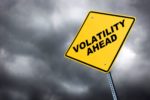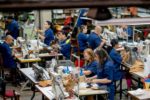
Home » With Suppliers Running at Near-Capacity, Is the ‘COVID Effect’ Finally Fading?
SCB FEATURE
With Suppliers Running at Near-Capacity, Is the ‘COVID Effect’ Finally Fading?

Photo: iStock.com/andresr
April 1, 2024
Are global supply chains finally shaking off the after-effects of the COVID-19 pandemic? The latest findings from GEP’s Global Supply Chain Volatility Index suggest that might indeed be the case.
In February, suppliers around the world were “very close to full utilization,” according to GEP’s new survey of the production orderbooks of some 27,000 businesses. That’s a sharp departure from the idle and under-utilized factories that were so prevalent over the last several years.
Activity in North America was especially strong in February, for which the index showed “stretched” supplier capacity, as manufacturers boosted inventories in expectation of ramped-up production in the near term. It was the first time since March, 2023 that suppliers to North America had been in that situation, GEP noted, “with backlogs ticking higher as a consequence.” Weaker results were seen in Europe, which continues to suffer from some economic stress, and Asia, held back by sluggish demand in Japan, Vietnam and Taiwan. Nevertheless, the index found, Asia saw signs of inventory restocking and economic resilience region-wide.
Globally, the rising demand for raw materials, commodities and components reversed a two-year trend of declines due to inflation and inventory drawdowns, GEP said. Surprisingly, the recent missile attacks on commercial shipping in the Red Sea have had a “negligible” impact on global supply chains, despite vessel diversions and longer voyage times. Global logistics costs actually fell in February.
News from the Red Sea “takes a lot of mindshare, even though it’s not having as big an impact as one would think,” says Mukund Acharya, GEP’s vice president of consulting.
For that month, “we saw supply chains being more utilized, suppliers are busier, and input demand and manufacturing are turning a corner after nearly a year of low-capacity utilization,” Acharya says.
Acharya cited passage of the Inflation Reduction Act and Bipartisan Infrastructure Law in the U.S. as contributors to renewed activity among suppliers to North America. The measures have helped to spark economic activity in construction, semiconductors and renewables, he said. Meanwhile, consumer demand has been strong.
On the labor side, which is widely believed to be in crisis mode on multiple fronts, while staffing availability was indeed falling short of optimal headcounts, the number was “only just above” historical levels. And no suppler reporting to the index said they were unable to meet demand because they couldn’t find enough workers. On the contrary, the COVID-driven labor shortages of 2021 and 2022 appear to be “waning,” he says. “A lot of my clients are not seeing that anymore.”
A good part of the reason why labor shortages aren’t disrupting operations in North America is automation. Acharya expects the trend toward adoption of robotics, especially in U.S. factories where labor costs are relatively high, to continue at the same rapid pace.
He says it’s difficult to “untangle” whether the recent rise in supplier output is a response to current consumer demand, or manufacturers’ anticipation of it. Still, many respondents reported strong existing demand, along with “anticipation that it will continue. So building up inventory makes sense. You don’t want to get caught with lower inventory and lose sales.”
The results of the latest GEP index can, of course, be viewed in a less positive light. The “glass half-empty” perspective worries that suppliers running at full capacity won’t be able to satisfy consumer demand, driving up prices and fueling inflation. “I don’t think it’s that extreme,” Acharya says, adding that companies will meet the demand by increasing investment in automation and more flexible manufacturing methods. It’s too early to tell whether the current trend in production levels and supplier capacity will result in inflationary pressure, he adds.
Others might point to the index as evidence that the U.S. economy, at least, is running dangerously hot. But Acharya doesn’t see the kind of regular price increases that augur renewed inflation, at least for the near term. On the contrary, GEP’s latest findings prompt him to describe the economy’s prospects with a word that wasn’t much in evidence in the last few years: “optimistic.”
RELATED CONTENT
RELATED VIDEOS
Subscribe to our Daily Newsletter!
Timely, incisive articles delivered directly to your inbox.
Popular Stories

2024 Supply Chain Management Resource Guide: There's Only One Way Off a Burning Platform
VIEW THE LATEST ISSUECase Studies
-

Enhancing High-Value Electronics Shipment Security with Tive's Real-Time Tracking
-

Moving Robots Site-to-Site
-
JLL Finds Perfect Warehouse Location, Leading to $15M Grant for Startup
-
Robots Speed Fulfillment to Help Apparel Company Scale for Growth
-
New Revenue for Cloud-Based TMS that Embeds Orderful’s Modern EDI Platform



